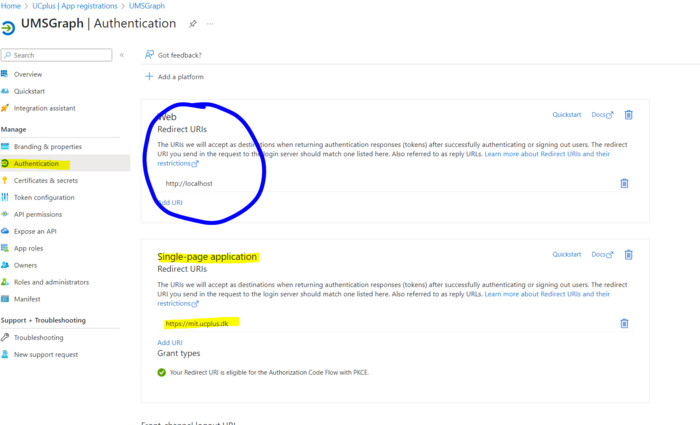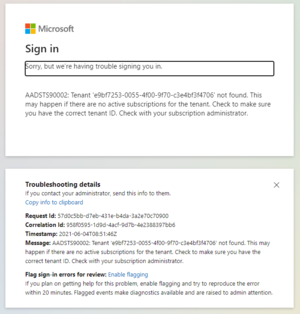Line 98:
Line 98: In most cases this would be something like <nowiki>https://ums.enterschoolnamehere.dk</nowiki>.
In most cases this would be something like <nowiki>https://ums.enterschoolnamehere.dk</nowiki>.
[[File:Azure_App_Registration_Authentication.png|none|thumb|700x700px]]
[[File:Azure_App_Registration_Authentication.png|frameless|300x300px]]
==FAQ :==
==FAQ :==
If you get this message when trying to connect it might be a matter of waiting for Client tenant distribution
If you get this message when trying to connect it might be a matter of waiting for Client tenant distribution
[[File:SSO login error message.png|left|thumb]]
[[File:SSO login error message.png|left|thumb]]
Revision as of 11:57, 22 September 2023
This feature requires the SSO module included in License
You also need Office365 Tenant settings to be setup in configurator (Must be same tenant as users are synced with)
How to use Office 365 as login provider instead of Active Directory
You need to create an Enterprise application
Login into portal.azure.com
Find Azure Active Directory
Find Enterprise applications
Click New application
Click Create your own application
Enter a name
Choose Integrate any other application you don't find in the gallery (Non-gallery)
Click Create (This will also create an App registration )
Find Properties for the Enterprise application you just created
Set User assignment required? and Visible to users? to false
Click Save
Click Single sign-on
Click SAML
Click edit under Basic SAML Configuration
Enter this in Identifier (Entity ID)
Enter the URL https://{URL}/{CustomerID} replace {CustomerID} with you number. This can be found in the configurator program under license info
Delete other URL's
Enter this in Reply URL (Assertion Consumer Service URL)
https://{URL}/SSO/AssertionConsumerServiceAzureAd.aspx
Under SAML Signing Certificate
Click download for Certificate (RAW)
This file must be placed in the root directory of your UMS Academic installation (Normally C:\inetpub\wwwroot)
Find Azure Active Directory
Find App registrations
Find your application that was created as an Enterprise applications
Click API permissions
Click Add a permission
Click Microsoft Graph
Click Application permissions
Add these permissions
User.ReadWrite.All
UserAuthenticationMethod.ReadWrite.All
Click Grant admin consent for {Tenant}
Open SQL Management Studio connect to the database
Run this SQL Command
Update UMSWebGeneralSettings Set SetSSO = 1
Open UMS web
You will be redirected to SSO setup
Click Add, enter a name and click Create
Choose the name in the drop down and click Edit
Click Add under the section Create new Single Sign On
Choose Azure AD in the Type drop down
In the boxes Name , SingleSignOnServiceUrl and SingleLogoutServiceUrl replace {TenantID} with the application id of your Enterprise application
The LocalCertificateFile must be entered with a PFX certificate. This file must be placed in the root directory of your UMS Academic installation (Normally C:\inetpub\wwwroot)
The LocalCertificatePassword must be entered to be able to read the PFX certificate
The PartnerCertificateFile is a certificate the is generated during Azure SSO setup (The file downloaded from Certificate (Raw) ). Remember to include the filename extension
This file must be placed in the root directory of your UMS Academic installation (Normally C:\inetpub\wwwroot)
Click Save
Click Enable
Click Save
Click Add to website
Choose website setting and click Add
Open UMS Configurator program
Click Web Setup
Select General settings
Select Azure AD in the Check login against drop down list
Open SQL Management Studio on the UMS Server and connect to the database
Run this SQL Command
Update UMSWebGeneralSettings Set SetSSO = 0
Restart IIS
The changes above may take some time to be distributed into Client Tenant system
Reset password for others
Go to Azure Active Directory
Click Roles and administrators
Find Password administrator
Click Add assignments
Find the name of the Enterprise application you created earlier
Select it and click Add
Change password
See also Password Change Azure AD
UMS Graph API connection in Office365 Tenant settings
When creating the Office365 tenant settings, just add the client_id and clientsecret from the SSO APP registration settings created above.
If this error occurs, this is most likely the authentication settings on the UMS App registration. Web should be filled out with localhost as the image below displays and the Single-page application should be your UMS Web URL.
In most cases this would be something like https://ums.enterschoolnamehere.dk.
FAQ :
If you get this message when trying to connect it might be a matter of waiting for Client tenant distribution

